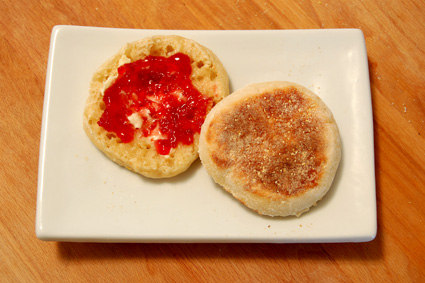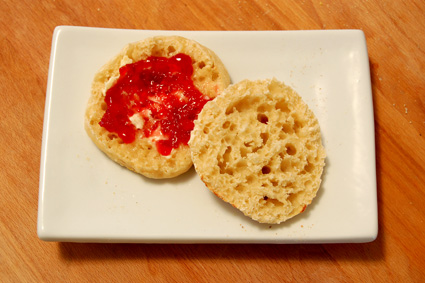It's taken a couple rounds of recipe tweaking, but I think I can finally say that I've got a pretty good recipe for English muffins:

This all started when I was researching the baking classes. I made notes on a variety of different bread recipes that I wanted to try for myself at some point - not necessarily for the class - and I've been fiddling with some of them, off and on, for a while. The most important adjustment I've made is to shift most of my breadmaking to weight measurements instead of volume, which means I'm able to produce more consistent results, and I'm more easily able to refine a recipe that's close but not perfect.
English muffins are the perfect example of that. The original recipe came from The World Encyclopedia of Bread and Bread Making by Christine Ingram and Jennie Shapter, a British book with lots of pictures that I'd picked up, years ago, in the bargain section of a Borders or Barnes & Noble. It calls for a cup and a half (or a little more) of milk per four cups of flour1 with a little added sugar - presumably for the yeast. The dough isn't kneaded, but is beaten together for several minutes to make it smooth and elastic. Roll, cut, proof, and cook on a lightly greased griddle.
What puzzled me, though, was that the accompanying picture, of a split English muffin, looks like a flat dinner roll. The interior has the soft, slightly ragged crumb of a kneaded, milk-based bread. Perhaps it's because I've only ever seen the standard Thomas' version, but I expect that crater-like interior. The nooks and crannies, as they say.
So I adjusted. The half-teaspoon of sugar's gone; I don't need it with instant yeast. My electric griddle's non-stick, and easier to clean if I leave it ungreased. And I don't feel like beating the dough for five minutes, so I stop after a minute. If that much.
Most importantly, though, I've increased the amount of milk used, which makes it easier to get those big air pockets inside. As additional insurance, I work the dough as little as possible - so no more punching down to get the bubbles out - and for all of this simplification and work reduction, I'm getting better and better results. This might be the simplest bread recipe I have.
These English muffins are great with butter or jam or both, though my personal favorite is to make egg sandwiches. Fried eggs over easy, with a little bit of a runny yolk, make a fine version, and cheese is definitely a plus. A bit of bacon and a dash of vinegary hot sauce can only improve things. The best, though, is to make little frittatas: scramble together an egg with some milk, cheese, and whatever additional stuff sounds good - last time it was mushroom and onion - and cook on the griddle in egg rings. Less messy than trying to layer it all on top, for one, and they look pretty sharp when stacked up.

English MuffinsSince I'm one for toasted English muffins, I'm more likely to make these in the evening, but they're easy enough to prepare fresh for a morning brunch. Just reduce the quantity of yeast - a scant half teaspoon, say - and use the milk at refrigerator temperature. Start them before you go to bed, and they'll be set for cutting and proofing come morning.
Makes six or seven
IngredientsDirections
- 270g bread flour (approx. 2 cups)
- 225g milk, lukewarm (approx. 1 cup less one Tablespoon)
- 1 teaspoon salt
- 3/4 teaspoon instant yeast
- Cornmeal or flour for dusting
- Mix together the flour, yeast and salt in a bowl, whisking thoroughly to combine. Add the milk, stirring until fully incorporated; there is no need to work it until smooth. Cover with plastic wrap and let rise until doubled in size, about an hour and a half.
- Turn the dough out onto a floured board, and dust the top with flour. Be sure to use enough flour to prevent the dough from sticking to the board or the rolling pin; this is a time when extra flour is not necessarily a bad thing. Roll out to about 3/8-inch thickness. Cut into rounds with a biscuit cutter. Gently press scraps together, kneading as little as possible, to cut additional English muffins. As with biscuits, the subsequent muffins may be a little more misshapen than the first set.
- Let the muffins proof on a sheet liberally dusted with cornmeal or flour, covered with plastic wrap, for half an hour. Meanwhile, preheat a griddle to 325°F (medium heat). Cook the muffins for about eight minutes per side, and allow to cool on a wire rack.
* * * * *
1Most of the recipes in the book make large quantities of bread, so I've tended to scale them down for my own use.

2 comments:
oh I wish I'd known you were looking for a recipe - I've been using the one at Baking Bites (which is, in turn, a modified version of Alton Brown's) for the past year or so. But yeah, I agree completely on forgoing the grease and also on the stir-slacking.
Well, I wasn't looking for a recipe in particular; it was more like I'd spotted a recipe, and figured I could make it work. The Baking Bites version looks similar - more liquid looks like it makes a batter that you drop onto the griddle like pancakes - but it's pretty close. I'll have to try them side-by-side sometime. She notes that hers have smaller holes than the commercial version. I think mine are pretty close, but it's been quite a while since I've had store-bought.
The other difference is probably that the drop version isn't always going to be perfectly round, whereas those made with a biscuit cutter could be. If you're careful.
Another odd note about the original recipe I modified: it recommends toasting them whole before splitting open the muffins. Also cutting around the edge with a sharp knife before tearing them apart. No mention of a fork anyplace.
Post a Comment